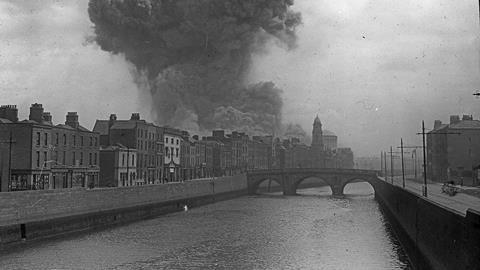A century ago today, London's legal press was covering two unsettling novelties. One was the arrival of women in the profession: the question of whether 'lady barristers' would or should wear wigs in court filled several column-inches.
The other was the birth of a new nation following the 1921 Anglo-Irish treaty. One concern, which resonates down the ages, was over the position of former servants of the Crown in Ireland. The Solicitors Journal noted a call by a member of the Law Society’s council to resettle legal staff of the Judge Advocate General’s Department, who were now in ‘daily danger of their lives’.
Notwithstanding the new constitutional arrangements, that spring, the lord chancellor was due to lead a grand procession at Dublin's Four Courts to mark the opening of a new legal term. The complex, dating from 1802, housed the Exchequer Court, the Court of Chancery, the Court of King’s Bench and the Court of Common Pleas under an imposing copper dome. Alongside was the Public Record Office, holding material going back to a papal grant dated AD 916.
But in the early hours of 15 April 1922, a convoy of lorries led by Rory O'Connor, a prominent figure in the Irish Republican Army and fierce opponent of the Anglo-Irish treaty, arrived to take up residence. The anti-treaty IRA had decided it needed a proper military headquarters, with offices and sleeping accommodation, for its ongoing campaign for a fully independent republic. The occupation was also intended to provoke the British, who still had substantial forces in Ireland, nervously cooling their heals under canvas after turning over most of their barracks to the free state's fledgling army.
In anticipation of an attack, the Four Courts were fortified with barbed wire and sandbags; the windows barricaded with furniture and leather-bound volumes. A munitions factory was established in the basement and a comandeered armoured car took up station outside.
There followed a strange interlude during which neither the British nor the provisional government rose to the bait. Members of the occupying force came and went at will, sometimes to drink with former comrades now wearing the newly-dyed green uniforms of the national army.
But tensions across Ireland were rising ahead of the free state's first general election. It was a time of what the state's first minister of justice, 30-year-old Kevin O’Higgins, later called 'a weird composite of idealism, neurosis, megalomania and criminality'. To the north, the birth of the new enclave of Northern Ireland was scarred with sectarian violence. On 22 June, IRA gunmen brought the conflict to London by assassinating one of the province's MPs, the distinguished soldier Field Marshall Sir Henry Wilson, outside his home. A furious prime minister Lloyd George told Michael Collins, chairman of the provisional government: 'The ambiguous position of the Irish Republican Army can no longer be ignored by the British government. Still less can Mr Rory O'Connor be permitted to remain with his followers an arsenal in open rebellion in the heart of Dublin'. Collins was asked 'formally' to bring the rebellion to an end.
At the urging of Winston Churchill, then secretary of state for the colonies, London made plans for unilateral military action. In the event, the free state's government, enfranchised with a convincing election victory, took matters in to its own hands. British involvement was limited to the willing loan of 18-pounder quick-firing field guns. (It is an article of faith in some quarters that they were served by British gunners, but a meticulous recent historian, Michael Fewer, can find no evidence of that. The national army had plenty of veterans with wartime experience of heavy weaponry, and the manner in which the guns were deployed - at point-blank range - demanded few of the artilleryman's specialist skills.)
At dawn on 28 June, the big guns opened fire with high explosive shells, apparently in the hope of prompting a 'shock and awe' surrender. The following day, the free state infantry went in. At lunchtime on 30 June, the complex was rocked by a huge explosion and the surviving garrison surrendered. The cause of the blast is still controverisal, but seems to have been the accidental detonation of munitions stored in the Public Record Office. Half an hour after the explosion, charred papers from law digests and law reports were still falling in suburban areas.
On 1 July, the Solicitors Journal in London reported: 'The danger which has threatened the law courts in Dublin has become acute this week, and there is great risk of destruction of books and documents. This is all part of the unhappy circumstances which have afflicted and still afflict the sister country, and upon which we are not entitled to write. But in a crisis which calls for sincere sympathy with the bench, bar, and solicitors in Ireland, we may emphasise the judicial and forensic learning and ability for which Ireland has always been famous, and which, transcending political differences, have made unity between the two countries.'
A week on, when the scale of the destruction had become clearer, the journal likened the destruction to the burning of Lord Mansfield's library by the 1780 Gordon rioters. 'Yet this, mutates mutandis, is only a small part of what the destruction of the Four Courts means to Dublin, and to all Ireland, North and South. It is really as if our own law courts, the Record Office and the Principal Registry of Wills, had simultaneous perished.’
A century on, a joint initiative by national archives in Dublin, Belfast and London is attempting to re-create the archive with technology, linking millions of words assembled from copies and transcripts of the lost documents. A 'Beyond 2022' website, to go live in June, will offer an immersive 3-D reconstruction of the destroyed building.
But back in 1922, the siege of the Four Courts was only the first battle of a bitter civil war. One of its notorious facets was the execution on dubious legal grounds of 83 men accused of IRA activity. One of them was Rory O'Connor: on 8 December 1922 he went before a firing squad in reprisal for the murder of a pro-treaty TD. The execution order was signed by O'Higgins, at whose wedding O'Connor had been best man the previous year.
In a civil war, friendship and justice are early casualties.
Pictured above: The explosion on 30 June 1922
Further reading:
- The Battle of the Four Courts, Michael Fewer, Apollo, 2018.
- The Irish Civil War: Law, Execution and Atrocity, Seán Enright, Irish Academic Press, 2022.



































1 Reader's comment